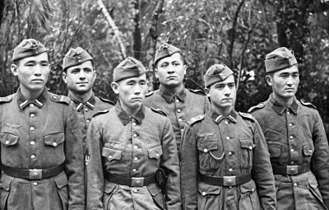Ostlegionen

Ostlegionen ("eastern legions"), Ost-Bataillone ("eastern battalions"), Osttruppen ("eastern troops"), Osteinheiten ("eastern units") were units in the Army of Nazi Germany, during World War II that were made up of personnel from countries comprising the Soviet Union. They represented a major subset within a broader number of the Wehrmacht foreign volunteers and conscripts.
Background
Members of the Ostlegionen units were conscripted or coerced into serving, whilst others volunteered. Many were former Soviet personnel, recruited from prisoner of war camps. Osttruppen were frequently stationed away from front lines and used for coastal defence or rear-area activities, such as security operations, thus freeing up regular Axis forces for front-line service. They belonged to two distinct types of units:
- Ost-Bataillone were composed of various nationalities, raised mostly amongst POWs captured in Eastern Europe, who had been formed into battalion-sized units, which were integrated individually into German combat formations, and;
- Ostlegionen were larger foreign legion-type units raised amongst members of a specific ethnic minority or minorities, and comprising multiple battalions.
Members of Osteinheiten usually faced execution or harsh terms of imprisonment, if they were captured by Soviet forces or repatriated to the USSR by the western Allies.
Ost-Bataillone
Ost-Bataillone wore German uniforms and equipment and were integrated into larger German formations. They began as the private initiatives of individual military commanders, but eventually became formalized and by late 1943 they contained 427,000 personnel, a force equivalent to 30 German divisions. Most were utilized on the Eastern Front and in the Balkans.
During 1944, a number of Ost-Bataillone were stationed in northern France, in anticipation of an Allied invasion of Western Europe. Units that fought in Normandy against Allied Operation Overlord were part of the German 243ed and 709th Static Infantry Divisions, positioned in the vicinity of the Utah, Juno and Sword invasion beaches.[1] Ost-Bataillone were also present in southern France, during the Allied landings codenamed Operation Dragoon (August 1944).
Ostlegionen
| Name of unit | Size and composition |
|---|---|
| Armenian Legion | Eleven battalions consisting of ethnic Armenians. |
| Azerbaijani Legion/Muslim Caucasus Legion | Composed of Azeris, Daghestanis, Chechens, Ingushes, and Lezghins. |
| 1st Cossack Cavalry Division | Cavalry division made up of Cossack volunteers; transferred in 1945 from the Wehrmacht to the Waffen-SS. |
| Georgian Legion | 14 battalions, consisting of ethnic Georgians. |
| Russian Liberation Army | Known as the "Vlasov Army"; a corps-sized formation composed mostly of Soviet citizens under the command of the former Soviet general Andrey Vlasov. |
| Turkestan Legion | 34 battalions, composed of Turkmens, Uzbeks, Kazakhs and other Central Asian nationalities; they saw action as the 162nd Turkoman Division, in Yugoslavia and Italy. |
| Ukrainian Liberation Army | Various Ukrainian units, some 180,000 personnel. |
| Kaukasisch-Mohammedanische Legion | Composed of Circassians, Daghestanis, Chechens, Ingushes, and Lezghins. |
| SS-Waffengruppe Krim | Two battalions of Crimean Tatars. |
See also
| Wikimedia Commons has media related to Ostlegionen. |